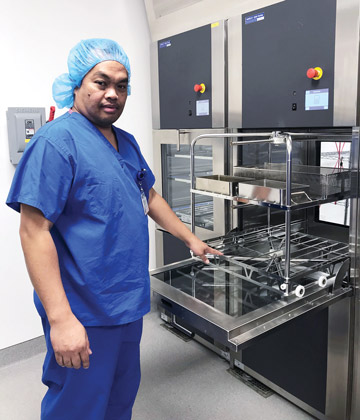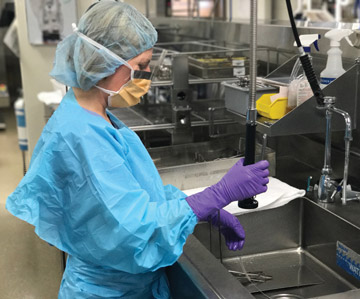Imagine a central sterile processing department that looks like a high-tech manufacturing facility, with employees working alongside advanced machines with conveyer belts, sending dirty instruments through the entire reprocessing cycle. After the instruments are automatically pulled through the washer-disinfector, technicians assemble clean instruments alongside robots that neatly and efficiently wrap finished trays in blue wrap. It seems like something out of a futuristic flick, but that's the future of the central sterile processing department thanks to new automation, robotics and even the exploration of virtual or augmented reality. Here are a few of the new trends in instrument reprocessing you should have on your radar.
- Home
- Article
Sterile Reprocessing Goes High Tech
By: Bob Marrs
Published: 4/24/2020
Automation, advanced imaging and even blue-wrap wrapping robots are transforming instrument care.
1. Automation
Nearly every reprocessing equipment manufacturer now offers some sort of automated washer-disinfector. These systems feature automated conveyors that pull racks full of instruments into the washer. All a staff member has to do is place the manually cleaned instrument tray on the rack, and the washer will do the rest.
This conveyer system not only frees up staff to focus on other tasks, but it also can extend the life of your equipment. How? When I worked in sterile processing departments, there were washers I favored over others. By automating the process, the instrument rack is systematically pulled into the next available washer, meaning they get equal use, which will cut down on the wear of the equipment.
When the washing cycle is finished, the washer pushes the racks out and onto a conveyor belt on the assembly side of the department. A staff member there can simply pick up the sets and place them onto their workstation before beginning to inspect and reassemble them. A similar principle applies here, with the double-sided sterilizers pulling in the carts, shutting the door, running the cycle and opening on the other side where the instruments are cooled and ready to be placed into storage.
As you can imagine, these types of systems can really help with productivity and throughput. Techs are free to perform their jobs more thoroughly when automated systems are in place. Often techs are too overwhelmed to focus on processes like manual cleaning or proper inspections of instruments. By adding automation to the mix, they don't have to take those extra steps of opening the washer, pushing the cart in and stopping what they're doing to start the cycle.
These automated machines come at an additional cost and have a slightly larger footprint, because you need to allow room for the conveyer systems on either side of the washer-disinfector and the sterilizer. But when you consider the time you will save, it's a great argument for making the department a little bigger.
2. Virtual or augmented reality

Virtual reality (VR) technology already exists for sterile processing departments. It's mainly targeted toward training and competency, but this type of technology and its potential for improved processes in sterile processing and other areas of health care are just beginning. ?Benefits of VR and augmented reality (AR) include increased information retention rates, repeatable training processes, and a cost-effective way to ensure productivity throughout training and competency verification. These technologies will also continue to impact how surgeons perform surgeries.
In the future, we may see the addition of voice-activated technology, which could also be a game-changer when working with complex and challenging instruments. Surveyors expect reprocessing techs to know the instructions for use (IFUs) for all the instruments in a facility — that means thousands of IFUs need to be accessible. When you're processing a device and searching for the IFU, you're wasting precious time. Instead, voice-activated technology would let staff pull up the IFU on command by saying the instrument make and model out loud.
3. Robotics
You know that robots are already in the OR, but they're also making a move to sterile processing. One of the coolest technologies I've seen recently is a robot that can wrap instrument trays in blue wrap after sterilization. During the demonstration I witnessed, the manufacturer had the robot wrapping one tray per minute. The robot folded the wrap, picked up the instrument tray, wrapped it, tore off a piece of tape and placed it on the wrap to secure it. Every set the robot wrapped was done with great consistency.
Even this simple action would be a huge help in sterile processing departments, especially in facilities with large amounts of loaner trays, such as those needed for complex orthopedic procedures. The last hospital I worked at received over 150 loaner trays on any given day. This meant we typically had to dedicate a single staff member each shift to just wrapping trays. The ability to pull that person to work on instrument assembly or other tasks while the robot did the wrapping would be incredible.
Additionally, robots are already being used in some larger healthcare communities for tasks like transporting clean and dirty carts to and from the OR. These robots can take clean case carts to the operating room, pick up the dirty ones and bring them to decontamination. They even can take the elevator themselves!
Robots could be a huge move forward in consistency in sterile processing. Think about it. Do you and your family members all perform cleaning tasks the same way? For areas where variability and human error can result in improperly processed instruments — like manual cleaning — robots could help to ensure a quality cleaned instrument every time. OSM

Looking to beef up your sterile processing department? Here's where to invest your dollars and workforce.
- Superior staffing. Your first focus should be to ensure reprocessing techs have what they need to do the job correctly each time. That includes education, training, certification and a livable wage. In most states, the person cutting your hair needs to complete a certification process, yet the people sterilizing instrumentation used inside the human body require nothing of the sort. Consider sending techs through robust certification programs or formal training, and ensure you have enough employees every day to limit the temptation to take shortcuts to turn around instruments to keep pace with the OR schedule.
- Plenty of instrumentation. When consulting, I frequently see technicians being forced to skip a cleaning step or shorten a sterilization cycle because they need to get an instrument set back to the OR as soon as possible. Having enough instrumentation on hand to last the entire day prevents this. You should ensure that every patient receives that same standard of care, and that includes making sure no shortcuts are taken in sterile processing.
- Equipment for your needs. When I visit facilities, I always ask if they're following instruments' IFUs during cleaning and disinfection, and usually get a rousing "yes." But once I get into the decontamination area, that's often not the case. Typically, this is due to a lack of equipment. For example, most orthopedic loaner trays require ultrasonic cleaning. If you don't have an ultrasonic cleaner in your department, you will not be compliant with instrument manufacturers' IFUs, no matter how thoroughly you think you're cleaning. Always remember that if a device isn't properly cleaned, it cannot be sterilized. You owe it to your patients to ensure that device manufacturers' IFUs are always followed.
- Continued improvement. Always look for ways to innovate and constantly investigate how to take your sterile processing department into the future. Augmented reality and virtual reality have already made their way into health care. The possibilities are endless with respect to technology's application in sterile processing. It can have a tremendous impact on instrument care and, ultimately, patient safety.
.svg?sfvrsn=be606e78_3)
.svg?sfvrsn=56b2f850_5)